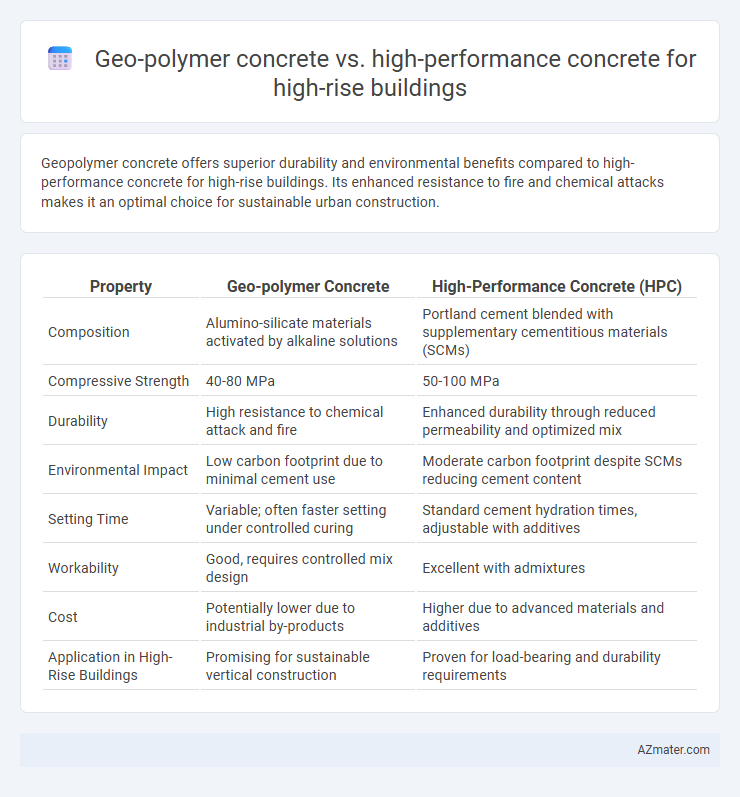Geopolymer concrete offers superior durability and environmental benefits compared to high-performance concrete for high-rise buildings. Its enhanced resistance to fire and chemical attacks makes it an optimal choice for sustainable urban construction.
Table of Comparison
| Property | Geo-polymer Concrete | High-Performance Concrete (HPC) |
|---|---|---|
| Composition | Alumino-silicate materials activated by alkaline solutions | Portland cement blended with supplementary cementitious materials (SCMs) |
| Compressive Strength | 40-80 MPa | 50-100 MPa |
| Durability | High resistance to chemical attack and fire | Enhanced durability through reduced permeability and optimized mix |
| Environmental Impact | Low carbon footprint due to minimal cement use | Moderate carbon footprint despite SCMs reducing cement content |
| Setting Time | Variable; often faster setting under controlled curing | Standard cement hydration times, adjustable with additives |
| Workability | Good, requires controlled mix design | Excellent with admixtures |
| Cost | Potentially lower due to industrial by-products | Higher due to advanced materials and additives |
| Application in High-Rise Buildings | Promising for sustainable vertical construction | Proven for load-bearing and durability requirements |
Introduction to Geo-polymer and High-performance Concrete
Geo-polymer concrete utilizes industrial by-products like fly ash or slag activated by alkaline solutions, offering superior chemical resistance and reduced carbon footprint compared to traditional binders. High-performance concrete (HPC) is engineered for enhanced strength, durability, and workability through optimized mix designs incorporating additives like silica fume and superplasticizers. Both materials are pivotal in high-rise construction, with Geo-polymer concrete promoting sustainability and HPC ensuring structural excellence under demanding load and environmental conditions.
Material Composition and Chemical Characteristics
Geopolymer concrete utilizes industrial by-products like fly ash or slag activated with alkaline solutions, offering superior chemical resistance and lower carbon footprint compared to traditional Portland cement-based high-performance concrete (HPC). HPC combines optimized proportions of cement, silica fume, and superplasticizers to achieve high strength and durability, with a dense microstructure that withstands mechanical stress in high-rise building applications. The distinct chemical composition of geopolymer concrete results in enhanced acid and sulfate resistance, making it preferable for aggressive environments, while HPC excels in compressive strength and rapid setting times vital for structural load demands in tall structures.
Mechanical Strength and Load-bearing Capacity
Geo-polymer concrete exhibits superior mechanical strength compared to traditional high-performance concrete, making it ideal for high-rise buildings requiring enhanced load-bearing capacity. Its higher compressive strength and improved durability under stress contribute to greater structural integrity and resistance to environmental degradation. High-performance concrete offers reliable strength but often falls short in long-term sustainability and load endurance when exposed to harsh conditions.
Durability and Service Life in High-rise Applications
Geopolymer concrete offers superior chemical resistance and thermal stability compared to high-performance concrete, enhancing durability in high-rise building applications exposed to aggressive environments. Its low permeability reduces chloride ion penetration and corrosion risk, extending the service life of structural components. High-performance concrete achieves high strength and durability but may require additional protective measures to match the long-term resilience provided by geopolymer concrete in tall structures.
Environmental Impact and Sustainability
Geo-polymer concrete, utilizing industrial by-products like fly ash and slag, significantly reduces carbon dioxide emissions compared to traditional Portland cement-based High-Performance Concrete (HPC), making it a more sustainable choice for high-rise buildings. HPC offers enhanced mechanical properties and durability but involves higher embodied energy and environmental footprint due to cement production. Employing geo-polymer concrete in tall structures supports sustainable construction by lowering greenhouse gas emissions and promoting waste reutilization without compromising structural performance.
Workability and Construction Techniques
Geo-polymer concrete offers improved workability with lower slump loss and better cohesiveness, enabling easier pumping and placement in high-rise buildings compared to high-performance concrete. High-performance concrete requires precise mix design and advanced curing techniques to achieve desired strength and durability, often involving controlled temperatures and moisture conditions during construction. Construction techniques for geo-polymer concrete emphasize rapid setting and ambient curing, reducing formwork time and accelerating construction cycles in tall structures.
Cost Analysis and Economic Feasibility
Geo-polymer concrete offers significant cost savings in high-rise building construction due to its utilization of industrial by-products like fly ash, reducing material expenses compared to traditional Portland cement in high-performance concrete. Economic feasibility improves as geo-polymer concrete lowers carbon emission taxes and energy consumption during production, offsetting initial technology adoption costs. High-performance concrete, although providing superior strength and durability, often incurs higher raw material and maintenance costs, impacting long-term economic efficiency in tall building projects.
Fire Resistance and Thermal Performance
Geo-polymer concrete exhibits superior fire resistance and thermal performance compared to high-performance concrete due to its inorganic polymer matrix, which can withstand temperatures exceeding 1000degC without significant strength loss. High-performance concrete, while offering enhanced mechanical properties, tends to suffer from microcracking and spalling under extreme heat, compromising structural integrity in high-rise buildings. The excellent thermal stability and low thermal conductivity of geo-polymer concrete make it a preferable choice for fire-resistant construction in tall structures.
Case Studies in High-rise Building Projects
Geo-polymer concrete demonstrates superior durability and reduced carbon footprint in high-rise building case studies such as the Sydney Opera House retrofit, showcasing enhanced fire resistance and chemical stability compared to traditional materials. High-performance concrete (HPC) is widely utilized in projects like the Burj Khalifa, providing exceptional compressive strength, workability, and reduced permeability, essential for structural integrity at extreme heights. Comparative analyses emphasize geo-polymer concrete's sustainability benefits, while HPC remains the benchmark for mechanical performance under high-stress conditions in tall structures.
Future Trends and Innovations in Concrete Technology
Geo-polymer concrete offers significant sustainability advantages with lower carbon emissions and enhanced chemical resistance, making it a promising alternative to traditional high-performance concrete in high-rise construction. Future trends emphasize the integration of nano-materials and AI-driven mix design optimization to improve durability and structural efficiency in both concrete types. Innovations also focus on enhancing the fire resistance and self-healing capabilities of geo-polymer concrete, addressing the evolving safety and maintenance demands of skyscrapers.

Infographic: Geo-polymer concrete vs High-performance concrete for High-rise building
 azmater.com
azmater.com